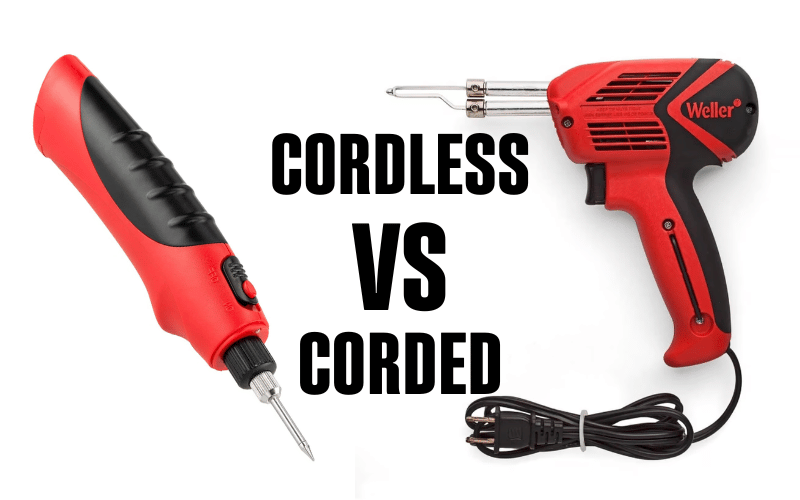Cordless vs Corded Soldering Irons: Which Is Right for You?

Introduction
Welcome to our comprehensive guide on the world of soldering irons! Whether you’re a hobbyist, DIY enthusiast, or professional, choosing the right soldering iron is crucial for your projects. In this article, we’ll delve into the key differences between cordless and corded soldering irons, exploring their benefits, drawbacks, and factors to consider when choosing. By the end, you’ll have the insights you need to make an informed decision for your next soldering project.
Benefits of Cordless Soldering Irons
Cordless soldering irons provide exceptional portability and convenience, making them a valuable tool for various soldering projects. Let’s dive deeper into the numerous benefits of using cordless soldering irons:
- Portability: With no reliance on a power outlet, cordless soldering irons offer the freedom to work on soldering tasks in any location. This portability is especially advantageous for outdoor or fieldwork projects where access to a power source may be limited.
- Quick and Efficient Use: Cordless models often boast rapid heat-up times, enabling swift and effective soldering. This feature is particularly beneficial for professionals and hobbyists who value speedy and precise results.
- Battery-Powered Versatility: The reliance on batteries makes cordless soldering irons well-suited for DIY projects, repairs, and on-the-go applications. This versatility allows users to tackle various tasks without being tethered to a power outlet. It also ensures uninterrupted workflow, making these tools an invaluable asset for mobile technicians and electricians.
- Enhanced Safety: The absence of a cord minimizes the risk of tripping hazards and accidental entanglement. This safety advantage contributes to a secure and comfortable soldering experience, especially in confined spaces or busy workshops.
Drawbacks of Cordless Soldering Irons
Cordless soldering irons offer portability and freedom of movement, making them an attractive choice for on-the-go soldering projects. However, there are several drawbacks associated with these tools that users should consider:
- Battery Life: One of the primary limitations of cordless soldering irons is their reliance on battery power. While this feature provides mobility, it also means that users must monitor battery life closely, especially during extended usage. The need for frequent recharging or battery replacements can disrupt workflow and lead to downtime.
- Heat Output: Some cordless soldering irons may not achieve the same level of heat output as their corded counterparts. This can impact their suitability for demanding soldering applications that require high temperatures or prolonged heat exposure.
- Weight Balance: Cordless soldering irons can sometimes have a less balanced weight distribution due to the integration of the battery, potentially causing user fatigue during longer soldering sessions.
- Initial Investment: Compared to corded models, high-quality cordless soldering irons can be more expensive, requiring a significant initial investment. This cost may deter some users, especially those who have limited use for a portable soldering iron.
Advantages of Corded Soldering Irons
Corded soldering irons offer several advantages that make them a preferred choice in various soldering applications. Here are some key benefits of corded soldering irons:
- Consistent Power: Unlike cordless soldering irons that rely on battery power, corded soldering irons provide a consistent and reliable power source throughout the soldering process. This ensures stable and uninterrupted heat for precision soldering tasks.
- No Battery Charging Required: With corded soldering irons, there’s no need to worry about battery charging or replacement. This eliminates the downtime associated with waiting for batteries to charge or having to replace depleted batteries during critical soldering projects.
- Extended Usage Time: Corded soldering irons can operate continuously for extended periods, making them suitable for prolonged soldering tasks without the need for frequent breaks to recharge or replace batteries.
- High Power Output: Corded soldering irons typically deliver higher power output compared to their cordless counterparts, allowing for faster heat-up times and efficient soldering, especially for heavy-duty soldering applications.
- Long-Term Cost Efficiency: While cordless soldering irons may incur ongoing costs for battery replacements, corded soldering irons offer long-term cost efficiency as they do not require regular battery replacements or recharging equipment.
These advantages make corded soldering irons an excellent choice for professionals and hobbyists who prioritize consistent power, extended usage, and cost-effective soldering solutions.
Disadvantages of Corded Soldering Irons
Corded soldering irons, while useful in many situations, do come with a set of drawbacks that need to be considered. It’s important to weigh these disadvantages against the advantages of corded soldering irons to make an informed decision for your projects. Let’s dive deeper into the specific disadvantages of corded soldering irons:
- Restricted Portability: One of the primary limitations of corded soldering irons is their dependency on a power source, which significantly restricts portability. This can be particularly challenging when working on projects in remote locations, outdoor settings, or confined spaces where access to power outlets is limited.
- Tripping Hazard: The reliance on a power outlet introduces the risk of tripping over cords, especially in busy workshop environments. This not only poses a safety concern but can also lead to interruptions and potential damage to the soldering iron or the project being worked on.
- Limited Flexibility: Corded soldering irons are limited by the length of the power cord, which can restrict movement and maneuverability when working on intricate or complex projects. This limitation may affect the precision and intricacy of soldering work, particularly in situations where the workspace is cramped or requires fine detailing.
- Tethered Operation: Working with a corded soldering iron requires constant attention to the placement of the cord, as it can inadvertently interfere with the soldering process. The need to manage the cord while maintaining a steady hand and focus on the solder joint adds an additional layer of complexity to the soldering task.
Despite these drawbacks, corded soldering irons remain a viable option for many soldering applications, especially in controlled workshop environments where a consistent power source is readily available.
Factors to Consider When Choosing
When deciding between cordless and corded soldering irons, several factors come into play. Consider the type and scale of your projects, your workspace environment, necessary heat control, and the duration of usage. Battery life, heat output, and ergonomics are also critical aspects to evaluate. By assessing these factors, you can make an informed decision that aligns with your soldering requirements.
Choosing the Right Soldering Iron for Your Projects
Choosing the right soldering iron for your projects involves a careful analysis of your specific needs. It is essential to consider a variety of factors to ensure that the soldering iron you select will meet the demands of your projects. In this section, we’ll delve into the key considerations and features that you should evaluate when choosing a soldering iron.
When selecting a soldering iron for your projects, there are several crucial factors that must be taken into account:
- Portability: Evaluate the level of portability required for your projects. If you need to work in different locations or within confined spaces, a portable soldering iron would be advantageous.
- Power Source: Consider whether a corded or cordless soldering iron would be more suitable for your needs. Cordless soldering irons offer greater mobility, while corded ones provide consistent power.
- Heat Output: Analyze the heat output required for your soldering tasks. Different projects may demand varying levels of heat output, so it’s important to choose a soldering iron that can deliver the necessary temperature.
- Precision Control: Precision is crucial in soldering, especially for delicate electronic components. Look for a soldering iron that offers precise temperature control and stability to ensure clean, accurate soldering joints.
- Research and Comparison: Take the time to research different soldering iron models, comparing their features and specifications. Seek recommendations from professionals in your field to gain valuable insights into the best options available.
By carefully evaluating these considerations, you can make an informed decision that aligns with the specific requirements of your projects. It’s essential to choose a soldering iron that provides the necessary portability, power, heat control, and precision for successful soldering.
Conclusion
In conclusion, the decision between cordless and corded soldering irons hinges on your unique requirements, project scope, and mobility preferences. While cordless irons offer unmatched portability, corded irons deliver consistent power and performance. Consider the benefits and drawbacks of each type, and weigh them against your specific soldering needs to arrive at the best choice for your projects. By understanding the factors at play and exploring their implications, you can confidently select the perfect soldering iron for your DIY endeavors or professional ventures.
